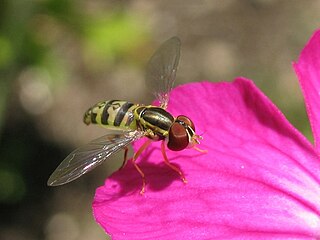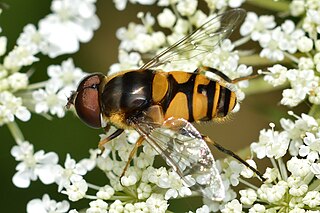
Toxomerus geminatus (Say,1823) the Eastern Calligrapher, is a common species of syrphid fly observed in the eastern and central United States and Canada.(see map) Syrphid flies are also known as Hover Flies or Flower Flies because the adults are frequently found hovering around flowers from which they feed on nectar and pollen. Adults are 6.1–7.6 mm (0.24–0.30 in) long. The larvae are predators of a variety of aphids and mites.
Dipteran morphology differs in some significant ways from the broader morphology of insects. The Diptera is a very large and diverse order of mostly small to medium-sized insects. They have prominent compound eyes on a mobile head, and one pair of functional, membraneous wings, which are attached to a complex mesothorax. The second pair of wings, on the metathorax, are reduced to halteres. The order's fundamental peculiarity is its remarkable specialization in terms of wing shape and the morpho-anatomical adaptation of the thorax – features which lend particular agility to its flying forms. The filiform, stylate or aristate antennae correlate with the Nematocera, Brachycera and Cyclorrhapha taxa respectively. It displays substantial morphological uniformity in lower taxa, especially at the level of genus or species. The configuration of integumental bristles is of fundamental importance in their taxonomy, as is wing venation. It displays a complete metamorphosis, or holometabolous development. The larvae are legless, and have head capsules with mandibulate mouthparts in the Nematocera. The larvae of "higher flies" (Brachycera) are however headless and wormlike, and display only three instars. Pupae are obtect in the Nematocera, or coarcate in Brachycera.

Eristalis flavipes, the orange-legged drone fly, is a species of hoverfly native to North America. It flies from early April to mid-October, and occurs in a wide variety of habitats, particularly wetlands. Hoverflies get their names from the ability to remain nearly motionless while in flight. The adults are also known as flower flies for they are commonly found around and on flowers, from which they get both energy-giving nectar and protein-rich pollen. The larvae are aquatic filter-feeders of the rat-tailed type.

Brachyopa flavescens, The Yellow Sapeater, is a fairly common species of syrphid fly. It has been observed in northeastern North America. Hoverflies get their names from the ability to remain nearly motionless while in flight. The adults are also known as flower flies for they are commonly found around and on flowers, from which they get both energy-giving nectar and protein-rich pollen. Larvae for this genus are of the rat-tailed type. B.flavescens larvae have not been described.
Blera nigra , the golden-haired wood fly, is a fairly common species of syrphid fly first officially described by Williston in 1887 Hoverflies get their name from the ability to remain nearly motionless while in flight The adults are also known as flower flies for they are commonly found around and on flowers from which they get both energy-giving nectar and protein rich pollen. The larvae are of the rat-tailed type feeding on exuding sap or in the rot holes of trees.
Orthonevra flukei (Sedman, 1966), Fluke's Mucksucker, is an uncommon species of syrphid fly It has been observed in the Western United States. Hoverflies get their names from the ability to remain nearly motionless while in flight. The adults are also known as flower flies for they are commonly found around and on flowers from which they get both energy-giving nectar and protein-rich pollen. Larvae for this genus are of the rat-tailed type. O. flukei larvae have been described.

Chrysogaster antitheus , the Short-haired Wrinkle Fly, is a fairly common species of syrphid fly found in North America. Hoverflies get their names from the ability to remain nearly motionless while in flight. The adults are also known as flower flies for they are commonly found around and on flowers, from which they get both energy-giving nectar and protein-rich pollen. The larvae in this genus are aquatic rat-tailed larvae.

Palpada vinetorum is a species of syrphid fly in the family Syrphidae. It is a native flower fly species to North America, mainly found in Texas and parts of the east coast.

Eristalis transversa, the transverse banded drone fly, is a common species of syrphid fly first officially described by Wiedemann in 1830. Hoverflies get their names from the ability to remain nearly motionless while in flight. The adults are also known as flower flies for they are commonly found around and on flowers, from which they get both energy-giving nectar and protein-rich pollen. The larvae are rat-tailed type but larvae of this specific species has not been reported.

Orthonevra nitida , the wavy mucksucker, is a fairly common species of syrphid fly. It has been observed in Eastern and Central North America. Hoverflies get their names from the ability to remain nearly motionless while in flight. The adults are also known as flower flies for they are commonly found around and on flowers from which they get both energy-giving nectar and protein rich pollen. Larvae for this genus are of the rat-tailed type. O. nitida larvae have not been described.
Microdon tristis is a species of syrphid fly in the family Syrphidae.

Arctosyrphus willingii, the northern longbeak, is a species of rat-tail maggot fly in the family Syrphidae. This species was formerly a member of the genus Lejops.

Microdon megalogaster, the black-bodied ant fly, is a species of syrphid fly in the family Syrphidae. It is found in north-eastern North America. The larvae have been found in the nests of Formica subsericea the black field ant, and Formica fusca the silky ant.

Blera pictipes, the painted wood fly, is a rare species of syrphid fly first officially described by Bigot in 1883. Hoverflies get their names from the ability to remain nearly motionless while in flight. The adults are also known as flower flies for they are commonly found around and on flowers, from which they get both energy-giving nectar and protein-rich pollen. The larvae are of the rat-tailed type, feeding on exuding sap or in the rot holes of trees.

Brachyopa daeckei, the black-tailed sapeater, is a rare species of syrphid fly that has been observed in northeastern North America. Hoverflies get their names from the ability to remain nearly motionless while in flight. The adults are also known as flower flies for they are commonly found around and on flowers, from which they get both energy-giving nectar and protein-rich pollen. Larvae for this genus are of the rat-tailed type. B.daeckei larvae have not been described.
Neoascia globosa , the Black-margined Fen , is a fairly common species of syrphid fly observed in northeastern North America. Hoverflies can remain nearly motionless in flight. The adults are also known as flower flies, for they are commonly found on flowers from which they get both energy-giving nectar and protein-rich pollen. The larvae are aquatic.

Brachyopa diversa , the pale-striped sapeater, is a rare species of syrphid fly. It has been observed in the northeastern part of North America. Hoverflies get their names from the ability to remain nearly motionless while in flight. The adults are also known as flower flies for they are commonly found around and on flowers, from which they get both energy-giving nectar and protein-rich pollen. Larvae for this genus are of the rat-tailed type. B.diversa larvae have not been described.

Sphiximorpha willistoni, or Williston's wasp fly, is a rare species of syrphid fly found in eastern North America. It is a strong wasp mimic. Hoverflies can remain nearly motionless in flight. The adults are also known as flower flies for they are commonly found on flowers, from which they get both energy-giving nectar and protein-rich pollen. Larvae in this genus are found in sap runs of trees.
Microdon ocellaris, the hairy-legged ant fly, is a rare species of syrphid fly observed in the eastern United States. Hoverflies can remain nearly motionless in flight. The adults are also known as flower flies for they are commonly found on flowers, from which they get both energy-giving nectar and protein-rich pollen. The larvae have been found in the nests of Formica pallidefulva.
Microdon ruficrus, the spiny-shield ant fly, is an uncommon species of syrphid fly observed in the eastern United States and adjacent Canada. Hoverflies can remain nearly motionless in flight. The adults are also known as flower flies for they are commonly found on flowers from which they get both energy-giving nectar and protein-rich pollen. Larvae have been found from the nests of Lasius americanus formerly Lasius alienus. GBIF external link to images















